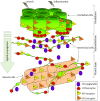Overactive bladder syndrome and the potential role of prostaglandins and phosphodiesterases: an introduction
- PMID: 24350100
- PMCID: PMC3842572
- DOI: 10.5812/numonthly.14087
Overactive bladder syndrome and the potential role of prostaglandins and phosphodiesterases: an introduction
Abstract
In this paper, a general introduction is given, presenting the overactive bladder syndrome (OAB) and its impact on the quality of life and economical burden in patients affected. Moreover, the anatomy, physiology and histology of the lower urinary tract are discussed, followed by a brief overview on the possible role of prostaglandin (PG) and phosphodiesterase type 5 (PDE5) in the urinary bladder. The current literature on the role and distribution of PGE2 and its receptors in the urinary bladder is discussed. In both animal models and in human studies, high levels of signaling molecules such as PG and cGMP have been implicated, in decreased functional bladder capacity and micturition volume, as well as in increased voiding contraction amplitude. As a consequence, inhibition of prostanoid production, the use of prostanoid receptor antagonists, or PDE inhibitors might be a rational way to treat patients with detrusor overactivity. Similarly, prostanoid receptor agonists, or agents that stimulate their production, might have a function in treating bladder underactivity.
Keywords: Phosphodiesetrase Type 5; Prostaglandins; Urinary Bladder; Urinary Bladder, Overactive.
Figures
Similar articles
-
The role of prostanoids in urinary bladder physiology.Nat Rev Urol. 2012 Mar 13;9(5):283-90. doi: 10.1038/nrurol.2012.33. Nat Rev Urol. 2012. PMID: 22410675 Review.
-
Changes of urinary nerve growth factor and prostaglandins in male patients with overactive bladder symptom.Int J Urol. 2005 Oct;12(10):875-80. doi: 10.1111/j.1442-2042.2005.01140.x. Int J Urol. 2005. PMID: 16323980
-
The role of prostanoids in the urinary bladder function and a potential use of prostanoid-targeting pharmacological agents in bladder overactivity treatment.Acta Pol Pharm. 2015 Jan-Feb;72(1):13-9. Acta Pol Pharm. 2015. PMID: 25850196 Review.
-
Is coexistent overactive-underactive bladder (with or without detrusor overactivity and underactivity) a real clinical syndrome? ICI-RS 2019.Neurourol Urodyn. 2020 Jul;39 Suppl 3:S50-S59. doi: 10.1002/nau.24311. Epub 2020 Feb 7. Neurourol Urodyn. 2020. PMID: 32032454 Review.
-
The role of phosphodiesterases in bladder pathophysiology.Nat Rev Urol. 2013 Jul;10(7):414-24. doi: 10.1038/nrurol.2013.101. Epub 2013 May 14. Nat Rev Urol. 2013. PMID: 23670184 Review.
Cited by
-
The five primary prostaglandins stimulate contractions and phasic activity of the urinary bladder urothelium, lamina propria and detrusor.BMC Urol. 2020 Apr 29;20(1):48. doi: 10.1186/s12894-020-00619-0. BMC Urol. 2020. PMID: 32349725 Free PMC article.
-
Neuromodulation for functional bladder disorders in patients with multiple sclerosis.Mult Scler. 2020 Oct;26(11):1274-1280. doi: 10.1177/1352458519894714. Epub 2019 Dec 9. Mult Scler. 2020. PMID: 31814519 Free PMC article. Review.
-
Effect of phosphodiesterase inhibitors in the bladder.Asian J Urol. 2015 Jan;2(1):33-37. doi: 10.1016/j.ajur.2015.04.014. Epub 2015 Apr 16. Asian J Urol. 2015. PMID: 29264117 Free PMC article. Review.
-
International Union of Basic and Clinical Pharmacology. CIX. Differences and Similarities between Human and Rodent Prostaglandin E2 Receptors (EP1-4) and Prostacyclin Receptor (IP): Specific Roles in Pathophysiologic Conditions.Pharmacol Rev. 2020 Oct;72(4):910-968. doi: 10.1124/pr.120.019331. Pharmacol Rev. 2020. PMID: 32962984 Free PMC article.
-
Low amplitude rhythmic contraction frequency in human detrusor strips correlates with phasic intravesical pressure waves.World J Urol. 2017 Aug;35(8):1255-1260. doi: 10.1007/s00345-016-1994-0. Epub 2016 Dec 26. World J Urol. 2017. PMID: 28025660 Free PMC article.
References
-
- Abrams P, Cardozo L, Fall M, Griffiths D, Rosier P, Ulmsten U, et al. The standardisation of terminology in lower urinary tract function: report from the standardisation sub-committee of the International Continence Society. Urology. 2003;61(1):37–49. - PubMed
-
- Haylen BT, de Ridder D, Freeman RM, Swift SE, Berghmans B, Lee J, et al. An International Urogynecological Association (IUGA)/International Continence Society (ICS) joint report on the terminology for female pelvic floor dysfunction. Neurourol Urodyn. 2010;29(1):4–20. doi: 10.1002/nau.20798. - DOI - PubMed
-
- Abrams P, Kelleher CJ, Kerr LA, Rogers RG. Overactive bladder significantly affects quality of life. Am J Manag Care. 2000;6(11 Suppl):S580–90. - PubMed
Publication types
LinkOut - more resources
Full Text Sources
Other Literature Sources
Research Materials




